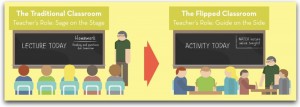The Huge Potential of a Flipped Language Classroom
Perhaps you’ve seen our list of activity ideas for the Extempore app. One of them brings up the idea of a “flipped” (or inverted) language classroom. Flipping the classroom isn’t really an activity; it’s more of an approach towards presenting–and ultimately putting into practice–the course content. What does this all mean exactly? Let’s talk about flipping a little more, then, because it’s still a bit of novel approach to teaching but it has a ton of potential, especially in the world language classroom.

The basic idea behind flipping a classroom is that the teacher provides the students with the “first exposure” to the new content outside of the classroom in anticipation of meeting face-to-face. The teacher can pre-record and deliver electronically the introductory information (e.g. new vocabulary, a grammar explanation, pronunciation) ahead of time. This frees up the teacher from the oftentimes burdensome task of lecturing the basics to a roomful of students, each of whom will be processing the new information at his or her own pace. But really, the true benefit of flipping lies in what happens in class with the extra time now that the lecture component has been given in advance. We teachers certainly understand that time is the most precious of resources!
Benefits of a Flipped Class
If you haven't "flipped" or "inverted" your classroom yet, you still might be wondering what all the fuss is about. Here are a few, but there are so many possibilities:
- Target language usage: We can maximize target language usage in the classroom by working on interactive activities, rather than slipping into English during a particularly difficult grammar explanation.
- Peer-teaching: students, when working together, frequently engage in scaffolding and peer-teaching, which can often be even more effective for some students than traditional teaching techniques.
- Richer, in-depth activities: Multi-part activities can develop more naturally with the extra class time and give students ample opportunities to use the language, rather than rushing through them near the end of the class period.

Flipping with Extempore
Extempore, of course, is a great way to flip your language classroom as it's a natural fit. So what would this look like for you and your students when you decide to flip the classroom with Extempore? Here are some ideas:
- Model standard pronunciation for students and ask that they submit their own attempts via the app. Then provide appropriate feedback to encourage improvement.
- Ask simple yes/no, true/false, or basic comprehension questions based upon a chapter's vocabulary list. Consider referencing images (either from the textbook or online) to guide them. Then, students submit their responses ahead of the next day's class.
- Present a simple explanation of a new grammar topic (e.g. the imperfect), and ask basic interview-style questions requiring correct verb usage. Students then answer via Extempore at home the night before class.
- Give a contextualized demonstration of a grammar topic (e.g. the preterit) through a basic narration. Students then submit three or four contributions that will extend your original narration.
The possibilities here seem almost unlimited, so give it a shot, and maybe "flipping" the classroom will add a new dimension to your classroom activities!


